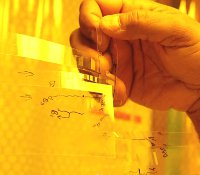- Home
- Research
- Education & Outreach
- Facilities
- Industry
CHM Pioneering Wearable Biosensors for Personalized Health Monitoring

Chances are good that when medical device manufacturers offer a wearable biosensing patch that will allow a nurse to monitor a patient’s blood sugar or insulin level remotely, for example, it was designed and the prototype built by polymer scientists at the University of Massachusetts Amherst led by Jim Watkins.
Watkins, who directs the National Science Foundation’s Center for Hierarchical Manufacturing (CHM) at UMass Amherst, says its research has helped to establish that such devices are feasible, and projects beginning this month at the new Center for Personalized Health Monitoring (CPHM) should soon lead to prototypes being developed and tested for commercialization.
The newly launched CPHM supported in part by a $95 million grant this year from the Commonwealth’s Life Sciences Center will build on foundations set in place through long-term NSF support.
“The first generation of these devices is coming out now, but they’re not there yet in terms of size, wearability, efficiency of data transmission and other important factors,” Watkins notes. “They need to be small, a bandage-sized patch rather than a helmet, in order to be useful for a physician monitoring a patient’s blood glucose or oxygen levels remotely. It all comes down to making a very small, light, flexible smart device that is relatively inexpensive to manufacture. We are getting close to that.”
Watkins says there is growing market interest in remote monitoring and personalized health care among hospitals and insurance companies, for example, who want to get people home from the hospital sooner at the same time collecting anonymous data to point the way toward improving care. Transmitting electrocardiograph, blood pressure monitor, heart rate and glucose/insulin data to a nurse, or being able to alert the clinic that a patient has fallen at home, could let someone stay more comfortably at less cost at home than in a nursing home or rehabilitation center, for example.
CHM’s polymer scientists and engineers are expert at building highly capable, nano-technology enabled devices on low-cost, high-volume production platforms such as roll-to-roll manufacturing and at integrating layers of such devices on patch-sized substrates rather than in a one-pound helmet, for example.
Working with local companies such as FLEXcon of Spencer, Mass., to develop device layers for flexible electronics, medical sensors, bonding systems and other applications, they can turn out devices much more efficiently and at lower cost than those built on conventional assembly lines that require expensive silicon wafers that must be handled multiple times in a vacuum or at very high temperatures.
“Think of printing a newspaper,” Watkins says, “except that we use rolls or ribbons of a flexible plastic substrate that is light, yet sophisticated enough to get the job done at far less cost. We are making layered devices with very small but reliable features such as sensors stamped on the plastic, transistors, battery-powered wireless communication capability and floating gate memory, and putting them on a flexible platform, a device that someone can wear.”
“We’re not the only ones in the country working on this by any means,” Watkins points out, “but we’ve made progress in a couple of critical areas to show that you can scale this up to the level of manufacturing.”
“We’ve built some unique tools that you won’t find anywhere else such as a roll-to-roll nanopatterning tool that deposits nanoparticle polymer device layers for flexible electronics and printed metal oxide layers that can perform tasks as well as devices prepared on a traditional semiconductor fabrication line without the cost. We’re make smarter, more efficient devices, with faster transistors, more sensitive sensors, using lower power, with more memory that performs a task we actually need.”
The team is currently trying to find the sweet spot on the cost-vs.-capability curve, which is unknown right now, Watkins adds. They will do pilot studies, and accelerate prototype development so that prototypes can be tested by kinesiologists such as Patty Freedson at UMass Amherst’s School of Public Health and Health Sciences and a co-chair at the CPHM.
Watkins says, “We work with dozens of companies both in Massachusetts and nationally, as well as branches of the U.S. military, who are waiting for short-lived, portable and wearable devices that can help make everyone, from soldiers on the battlefield to elderly parents living at home alone, safer at an affordable cost.”
Source: Janet Lathrop - UMass News













